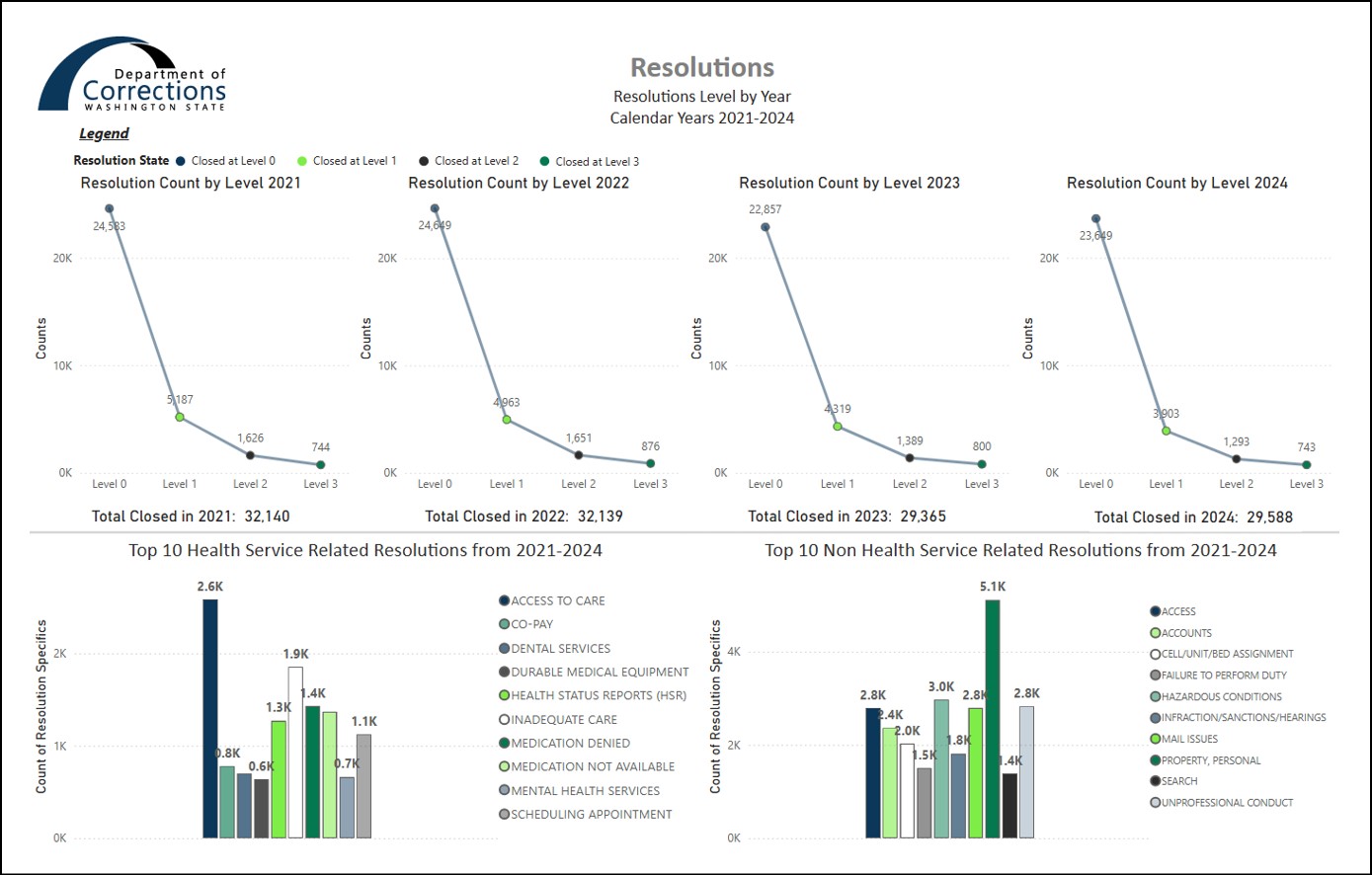About
The Department of Corrections' Resolution Program is an unbiased, internal resolution and appeal system that promotes effective communication between employees, contract staff, volunteers and justice involved individuals under the department's jurisdiction in an effort to resolve concerns at the lowest possible level. It provides an appropriate administrative avenue for voicing complaints without fear of retaliation.
Individuals have access to a process that enables meaningful communication to resolve concerns and reach a fair and just conclusion, while also supporting the development of problem-solving skills. It further offers a collaborative approach to addressing the individuals' concerns with a human-centered approach. which aligns with the Prison Litigation Reform Act (PLRA) of 1996.
Resolution Request Data From 2021-2024

The total number of complaints processed by the Statewide Resolution Program in 2024 was 29,588
The best outcome is an Informal Resolution
An Informal Resolution occurs when the parties involved reach a mutually agreed-upon outcome, or when the outcome benefits the justice-involved individual. Informal Resolutions can be appealed if the outcome or response is not favorable to that individual.
Program Limits
Individuals may have up to five active Resolution Requests at any given time. These include active reviews, rewrites, appeals, and newly filed concerns. Medical and Transgender issues can be accepted beyond this limit with approval from the Resolution Program Manager or their designee. If a review has been granted a second extension, it will not count against the individual's current active Resolutions.
Resolution Process
Requests
A Resolution Request is where an individual can identify a concern about any one issue that is affecting them directly. All requests must meet the criteria as outlined in the Resolution Program Manual. All justice involved individuals are provided with information needed to file a Resolution Request during their orientation/intake process at our receiving facilities. Resolution Request Forms are readily available and the Resolution Program Manual is available at each prison, reentry location, and field office to guide individuals through the complaint and review process.
Before filing a Resolution Request, individuals are encouraged to participate in the Informal Resolution process by discussing their concern with staff in an attempt to clear up any misunderstandings by clarifying information. If an Informal Resolution cannot be reached and the individual feels further review of their concern is necessary, they may submit an appeal to the Resolution Specialist's response.
For information concerning Accepted and Not Accepted concerns, please review the Resolution Program Manual and DOC 550.100 Resolution Program.
The justice-involved individual will need to fit the entire written concern in the description section of one DOC 05-165 Resolution Request, presenting a simple and straightforward statement that outlines the issue or incident in need of a solution. The individual will need to identify the “who, what, when, why, where, and how” surrounding the issue or incident. It is also necessary to provide any physical evidence in their possession to support their allegation. If there are potential witnesses, the individual will need to identify them in their Resolution Request. For requests concerning changes to policy, the individual needs to specify which part of the policy is deficient and provide a recommendation for change.
Outcomes
The Resolution Program provides access to a process that enables meaningful communication and the resolution of concerns to produce a fair and just outcome. It offers a collaborative approach to addressing the individual's concerns while identifying miscommunications and areas in need of positive impacts to policies and practices.
The following program outcomes are the available responses to concerns:
| Substantiated | There is evidence to support and prove the truth of the allegation. |
|---|---|
| Unsubstantiated | The accusation, or the defense of the accused, is not supported or proven by the evidence available. |
| Unfounded | Irrefutable evidence that the allegation is not based on fact (e.g. video, telephonic recording, photos, etc.). |
Timeframes
Specific timeframes are set at each level to ensure a prompt response to Resolution Requests. The entire Resolution process from initiating Level I to completion of Level III can be completed within 90 working days. However, the process can take longer than 90 days in some cases due to rewrites, mail delays, or a complicated review. It is the responsibility of both the employee assigned to the review and individuals to ensure Resolution Requests, Appeals, and responses occur within established timeframes.
| Initial Resolution Request | An individual must submit within 30 days from the date of the incident |
|---|---|
| Level 0 Response | Issued 10 working days from the date of receipt/pickup |
| Rewrite Requests | An individual must submit within 10 working days from the date of the Rewrite Request |
| Appeals of Response | All appeals must be received within 10 business days |
| Level 1 Response | Issued by the RS within 15 working days from the date the review has been initiated |
| Level 2 Response | Issued by the Appointing Authority within 15 working days from the date the review has been initiated |
| Level 3 Response | Issued by HQ within 15 working days from the date the review is initiated |
For more information on the response timeframes to a Resolution Request, please review the timeframes section in the Resolution Program Manual.
Peer Support Program
The Resolution Program Offers a Peer Support Program at all Major Institutions
The Resolution Peer Support Program aims to support and build trust within the Resolution Program. This voluntary support program helps individuals in a peer setting to better understand the Resolution Program and receive support in reading, writing, and rewriting their complaints. The Resolution Peer Support person can also aid in navigating other DOC internal appeal processes to ensure that all individuals receive proper support from DOC. This helpful program has demonstrated positive outcomes and offers a decrease in the filing of complaints. The data shows a fewer than one-third of participants end up filing complaints after meeting with their peer mentor. This also helps stop further delays in receiving their outcome from the correct process.
| Facility | AHCC | CCCC | CBCC | CRCC | MCCW | MCC | OCC | SCCC | WCC | WCCW | WSP | Totals |
|---|---|---|---|---|---|---|---|---|---|---|---|---|
| Signed Up | 31 | 26 | 38 | 91 | 37 | 84 | 307 | |||||
| Resolutions Filed | 12 | 7 | 16 | 9 | 9 | 5 | 58 | |||||
| Resolutions Not Filed | 17 | 19 | 14 | 58 | 28 | 77 | 213 | |||||
| Resolutions Appealed | 2 | 8 | 4 | 2 | 2 | 18 | ||||||
| Percentage of complaints not filed: 65% | ||||||||||||
| Facility | AHCC | CCCC | CBCC | CRCC | MCCW | MCC | OCC | SCCC | WCC | WCCW | WSP | Totals |
|---|---|---|---|---|---|---|---|---|---|---|---|---|
| Signed Up | 22 | 16 | 35 | 115 | 37 | 63 | 288 | |||||
| Resolutions Filed | 8 | 6 | 15 | 9 | 14 | 1 | 53 | |||||
| Resolutions Not Filed | 14 | 6 | 7 | 59 | 19 | 54 | 159 | |||||
| Resolutions Appealed | 4 | 13 | 6 | 4 | 8 | 35 | ||||||
| Percentage of complaints not filed: 45% | ||||||||||||
| Facility | AHCC | CCCC | CBCC | CRCC | MCCW | MCC | OCC | SCCC | WCC | WCCW | WSP | Totals |
|---|---|---|---|---|---|---|---|---|---|---|---|---|
| Signed Up | 34 | 18 | 2 | 19 | 80 | 18 | 63 | 234 | ||||
| Resolutions Filed | 4 | 11 | 2 | 18 | 4 | 6 | 3 | 48 | ||||
| Resolutions Not Filed | 26 | 7 | 0 | 7 | 74 | 10 | 57 | 181 | ||||
| Resolutions Appealed | 4 | 0 | 0 | 5 | 2 | 1 | 3 | |||||
| Percentage of complaints not filed: 42% | ||||||||||||
Reentry Centers
Reentry Centers serve as a bridge between life in prison and life in the community. Justice-involved individuals focus on transitioning, including finding and retaining employment, pursuing education, receiving treatment, reconnecting with family members, and developing life skills. Individuals learn and refine social and living skills to create a smoother transition from prison confinement to full-time community life. This includes utilizing the Resolution Program responsibly and collaborating with staff to address concerns and issues through open and respectful communication. The Reentry Center Managers (RCM) are the identified Resolution Specialist for the Reentry Centers.
Community Supervision/GRE
Community Supervision services are delivered in the 86 field offices, Community Justice Centers (CJC), Community Oriented Policing (COP) Shops, and outstations across the state. These locations are used for programming and also serve as reporting points for individuals under Community Supervision. The Headquarters Resolution Unit serves as the Resolution Specialist for all 86 field offices. Justice-involved individuals can call, email or write to Headquarters to have their concerns addressed through the Resolution Program.
Resources
Policies
Below are Department of Corrections (DOC) policies that apply to the Resolution Program.
Forms
Below are Department of Corrections (DOC) forms that apply to the Resolution Program.
Publications
Below are Department of Corrections (DOC) publications that apply to the Resolution Program.
- Statewide Resolution Program – Fact Sheet 500-GU010
- Resolution Program Manual 500-HA006
- Manual del Programa Resolución 500-HA006s
- Resolution Program Orientation Brochure 500-BR006
- Programa de Resolución 500-BR006s
- Resolution Program Pocket Guide 500-PA001
- Guía de Bolsillo del Programa de Resolución 500-GU005s
- Resolution Program Handout 400-GU023
- Folleto Del Programa De Resolución 400-GU023s

